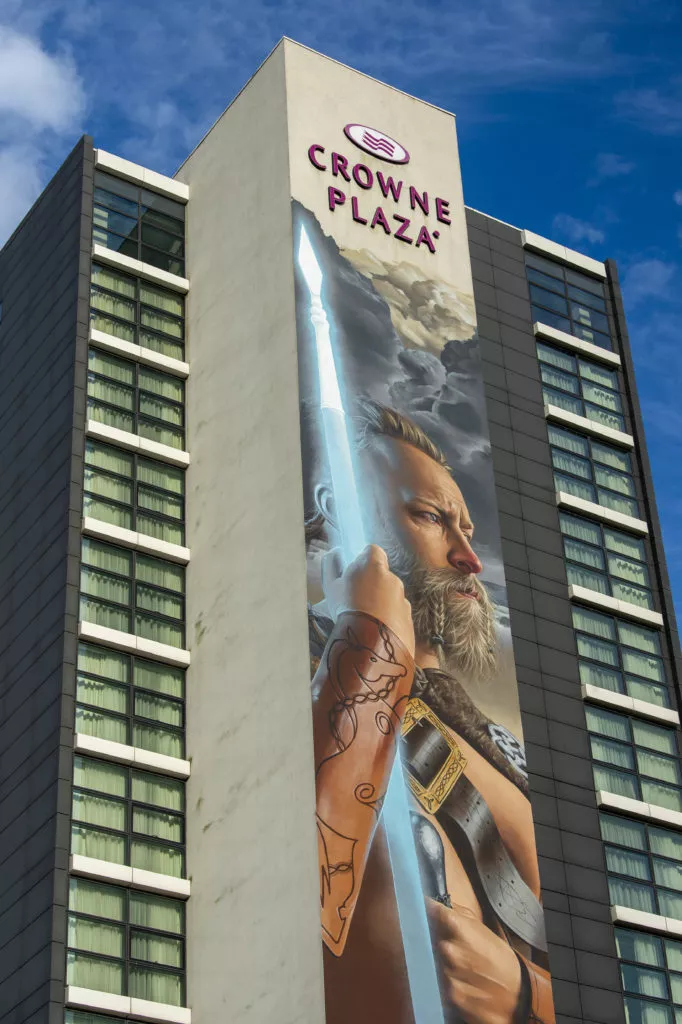On my commute to Trinity, I pass the same buildings leaving Dundalk, heading onward towards the motorway. Red brick terraced houses, the local hospital, the Dundalk Institute of Technology campus and lastly, at the edge of Dundalk’s exit, the Crowne Plaza hotel. These buildings — ordinary as small-town constructions tend to be — have remained unchanged for many years, until now. In the last few weeks, the once-beige wall of the Crowne Plaza hotel has come to life with a magnificent mural. The project was organised by Seek Dundalk, whose mission is to refocus “the perception of Dundalk” and to “promote contemporary art” in the town, funded by Creative Spark.
The mural is now officially the tallest in Ireland and is of Lugh/Lú, the warrior God of light and the namesake of Co. Louth. According to ancient myth, Lugh arose from the dead, fell in love with a mortal being and had their son Cú Chulainn. He is known for wielding a huge spear and sword when fighting in his many battles. He famously arrived at Cú Chulainn’s side whilst injured during the combat of the Cattle Raid of Cooley (Táin Bó Cuailagne).
“He was known for being incredibly big, bold and strong, conveyed on Ireland’s tenth tallest building.”
The mural on the Crowne Plaza portrays Lugh perfectly. He was known for being incredibly big, bold, and strong; it is fitting, then, that he is conveyed on Ireland’s tenth tallest building. He gazes out at the horizon with his glowing spear in hand and his trusty hound, Failinis, on the end of the mural.
I spoke to Martin McElligott, the Town Centre Commercial Manager about the mural and Seek Dundalk’s involvement. He said that the reaction of the town in response to the artwork went beyond expectations. The people of the area have completely fallen in love with the mural, taking different pictures with their families and researching the myth surrounding Lugh on the wall, once a blank canvas. This has not just been a local reaction. The organisation has received praise for the mural nationally and internationally with people’s curiosity being captured globally by the Irish warrior god painted on the side of a hotel building.
“After all, Louth is known as the ‘Land of Legends’ for a reason, being highly associated with mythology and folklore.”
It was felt by the organisation that many people from Dundalk were not aware of the rich history the region possesses. After all, Louth is known as the “Land of Legends” for a reason, being highly associated with mythology and folklore. The artist behind the project was Australian-born Sam Bates, also known as “Smug” or “Smug One”. It took two years for the organisation to get hold of him for the project. The theme of the region’s folklore encouraged Smug to take on the project, according to McElligott. Artists like Smug love working with concepts or themes instead of a literal blank slate with no direction.
The project was in development for an incredibly long time and despite COVID-19 restrictions, Seek Dundalk managed to make it work. The planning and organisation made this project a “once in a lifetime opportunity”, as timing was of the essence, to include it in the organisation’s Seek festival. Many approvals had to be made before Smug could lay a drop of paint on the building. For example, the owners of the hotel in the United States had to grant permission. In particular, consideration was given on whether it would affect the market value of the property in the future.
Those who observed the mural being developed over the twelve day period last September might assume that that was all the time required to get the project over the line. They could not be more wrong.
“He guards the entrance of Dundalk for those looking out miles ahead, as if symbolically, overnight once again as in legend, he becomes our land’s protector.”
The mural is without a doubt, something to admire on my usual commute up and down to Dublin. As I return home from a long day in college, people on my bus are looking out the window as we enter the town again and become completely mesmerised with the magic that Lugh has brought to the entrance of this town. He stands proud of his people, proud of his county, and proud of the land he represents. He guards the entrance of Dundalk for miles ahead, as if symbolically he has once again become our land’s protector as in legend.
The mural itself is a symbol of the region’s culture in recent times. Many people in Ireland do not know Dundalk’s mythological history the way they know Tír na nÓg’s or Saint Patrick’s. This area of Irish culture has been neglected and somewhat forgotten. With the rise of COVID-19 infections last year, and people heading into isolation and lockdown, the hospitality industry became abandoned while restrictions remained. The hotel has been reignited with the colour and beauty that Smug brought in his design of Lugh, and now, because of the public’s fascination with the mural, they are becoming more interested in the heritage of the area and this part of Irish culture.






